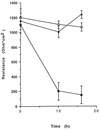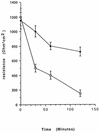Escherichia coli cytotoxic necrotizing factor 1 effaces microvilli and decreases transmigration of polymorphonuclear leukocytes in intestinal T84 epithelial cell monolayers
- PMID: 9596707
- PMCID: PMC108229
- DOI: 10.1128/IAI.66.6.2494-2500.1998
Escherichia coli cytotoxic necrotizing factor 1 effaces microvilli and decreases transmigration of polymorphonuclear leukocytes in intestinal T84 epithelial cell monolayers
Abstract
Cytotoxic necrotizing factor type 1 (CNF1), a 110-kDa toxin-like protein from pathogenic Escherichia coli strains, induces an actin cytoskeleton reorganization consisting of the formation of prominent stress fibers by permanent activation of the small GTP-binding protein Rho. Since p21Rho regulates tight-junction permeability and perijunctional actin reorganization in epithelial intestinal cells (A. Nusrat, M. Giry, J. R. Turner, S. P. Colgan, C. A. Parkos, E. Lemichez, P. Boquet, and J. L. Madara, Proc. Natl. Acad. Sci. USA 92:10629-10633, 1995), we used polarized T84 epithelial intestinal cell monolayers to examine whether CNF1 could affect microvillus structure, transepithelial resistance, and polymorphonuclear leukocyte (PMN) transmigration. Incubation of T84 cells with CNF1 did not influence transepithelial resistance, suggesting that barrier function and surface polarity were not affected by the toxin. However, CNF1 effaced intestinal cell microvilli and induced a strong decrease of PMN transepithelial migration in either the luminal-to-basolateral or the basolateral-to-luminal direction. CNF1 could thus be a virulence factor exhibiting a new type of combined activity consisting of effacing of microvilli and occlusion of the epithelial barrier to PMNs. Attenuated transepithelial migration of PMNs could result in the enhanced growth and protection of luminal bacteria.
Figures






Similar articles
-
Neutrophil migration across cultured intestinal epithelial monolayers is modulated by epithelial exposure to IFN-gamma in a highly polarized fashion.J Cell Biol. 1993 Feb;120(3):785-98. doi: 10.1083/jcb.120.3.785. J Cell Biol. 1993. PMID: 8093887 Free PMC article.
-
Neutrophil F-actin and myosin but not microtubules functionally regulate transepithelial migration induced by interleukin 8 across a cultured intestinal epithelial monolayer.Eur Cytokine Netw. 1999 Jun;10(2):227-36. Eur Cytokine Netw. 1999. PMID: 10400829
-
Activation of Rho GTPases by Escherichia coli cytotoxic necrotizing factor 1 increases intestinal permeability in Caco-2 cells.Infect Immun. 1998 Nov;66(11):5125-31. doi: 10.1128/IAI.66.11.5125-5131.1998. Infect Immun. 1998. PMID: 9784513 Free PMC article.
-
Cytotoxic necrotizing factor 1 from Escherichia coli: a toxin with a new intracellular activity for eukaryotic cells.Folia Microbiol (Praha). 1998;43(3):285-9. doi: 10.1007/BF02818614. Folia Microbiol (Praha). 1998. PMID: 9717256 Review.
-
The cytotoxic necrotizing factor 1 (CNF1) from Escherichia coli.Toxicon. 2001 Nov;39(11):1673-80. doi: 10.1016/s0041-0101(01)00154-4. Toxicon. 2001. PMID: 11595630 Review.
Cited by
-
Cytotoxic necrotizing factor type 1 of uropathogenic Escherichia coli kills cultured human uroepithelial 5637 cells by an apoptotic mechanism.Infect Immun. 2000 Oct;68(10):5869-80. doi: 10.1128/IAI.68.10.5869-5880.2000. Infect Immun. 2000. PMID: 10992497 Free PMC article.
-
Effect of Helicobacter pylori on polymorphonuclear leukocyte migration across polarized T84 epithelial cell monolayers: role of vacuolating toxin VacA and cag pathogenicity island.Infect Immun. 2000 Sep;68(9):5225-33. doi: 10.1128/IAI.68.9.5225-5233.2000. Infect Immun. 2000. PMID: 10948148 Free PMC article.
-
Prevalence of virulence genes in Escherichia coli strains isolated from Romanian adult urinary tract infection cases.J Cell Mol Med. 2001 Jul-Sep;5(3):303-10. doi: 10.1111/j.1582-4934.2001.tb00164.x. J Cell Mol Med. 2001. PMID: 12067489 Free PMC article.
-
The Regulation of Intestinal Mucosal Barrier by Myosin Light Chain Kinase/Rho Kinases.Int J Mol Sci. 2020 May 18;21(10):3550. doi: 10.3390/ijms21103550. Int J Mol Sci. 2020. PMID: 32443411 Free PMC article. Review.
-
Synergy in polymicrobial infections in a mouse model of type 2 diabetes.Infect Immun. 2005 Sep;73(9):6055-63. doi: 10.1128/IAI.73.9.6055-6063.2005. Infect Immun. 2005. PMID: 16113326 Free PMC article.
References
-
- Boquet, P., et al. Unpublished data.
-
- Chardin P. Structural conservation of Ras-related proteins and its functional implications. In: Dickey B F, Birnbaumer L, editors. Handbook of experimental pharmacology, GTPases in biology. Heidelberg, Germany: Springer Verlag; 1993. pp. 159–176.
Publication types
MeSH terms
Substances
LinkOut - more resources
Full Text Sources

